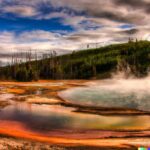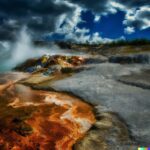Planning a trip to Yellowstone National Park? Before you embark on your adventure, it’s crucial to understand the importance of practicing responsible tourism and taking necessary safety precautions. From following park rules and regulations to respecting wildlife and supporting local businesses, there are key practices to ensure you have a safe and enjoyable experience. Join us as we explore the essential tips for enjoying Yellowstone responsibly and safely.
Why Is It Important to Practice Responsible Tourism at Yellowstone?
Practicing responsible tourism at Yellowstone National Park is crucial for the preservation of its natural beauty and ecosystems while ensuring the safety and well-being of visitors.
By following safety precautions and adopting sustainable practices, visitors can help protect the delicate ecological balance of the park. Adhering to national park regulations such as staying on designated trails, not feeding the wildlife, and properly disposing of waste is essential in minimizing human impact on the environment.
Respecting wildlife by observing them from a safe distance and refraining from approaching or disturbing them contributes to their well-being and preserves their natural behaviors. Being mindful of the fragility of the ecosystem and following visitor safety guidelines ultimately allows everyone to enjoy the park responsibly and ensure its conservation for future generations.
What Are the Safety Precautions to Take While Visiting Yellowstone?
Ensuring visitor safety at Yellowstone National Park involves taking necessary safety precautions to mitigate risks and handle emergencies effectively.
Visitors are advised to maintain a safe distance from wild animals such as bison, elk, and bears to avoid potential attacks. It is crucial to never feed or approach wildlife as it can lead to dangerous situations. Tourists should stay on designated trails and follow park rules to prevent accidents.
Awareness of geothermal hazards, such as hot springs and geysers, is essential to avoid burns or injuries. In case of emergencies, visitors should contact park authorities immediately and be prepared to provide precise location details for swift assistance.
Follow Park Rules and Regulations
Adhering to Yellowstone National Park’s rules and regulations is essential to ensure a safe and enjoyable visitor experience while preserving the park’s natural habitats and resources.
- Park authorities have implemented various guidelines to safeguard both visitors and wildlife within the park.
- It is crucial for visitors to:
- stay on designated trails,
- not disturb the wildlife, and
- properly dispose of waste
to maintain the ecosystem’s delicate balance.
- Understanding and obeying these regulations also help in preventing accidents and minimizing human impact on the environment.
By respecting park facilities and exhibiting responsible behavior, visitors contribute to the long-term sustainability of Yellowstone’s beauty and diversity. Failure to comply with park policies can result in fines, harm to the park’s flora and fauna, and disturbances to other visitors’ experiences.”
Be Aware of Wildlife
Encountering wildlife at Yellowstone National Park is a thrilling experience that requires caution and respect to ensure the preservation of the park’s diverse animal species and their natural habitats.
When observing wildlife, it is crucial to maintain a safe distance to prevent disturbing the animals and to avoid any potential danger. Yellowstone visitors should refrain from feeding any wildlife they encounter, as human food can harm their health and alter their natural behaviors. Understanding the behavioral patterns of different species is also key to ensuring a safe and respectful observation experience. By respecting wildlife protection guidelines and minimizing human impact on their habitats, visitors can contribute to the long-term conservation efforts in Yellowstone.
Be Prepared for Changing Weather Conditions
Yellowstone’s weather can be unpredictable, requiring visitors to be prepared for sudden changes to ensure their safety and well-being during outdoor activities.
One key aspect of preparation is dressing in layers, which allows you to adjust to fluctuating temperatures effortlessly. It is advisable to wear moisture-wicking clothing as a base layer, insulating layers for warmth, and a waterproof outer layer to shield against rain or snow.
Carrying essential gear such as a first aid kit, extra food and water, a map, compass, and flashlight is vital. Being aware of weather advisories and consistently checking weather forecasts before heading out on hiking trails or wildlife watching expeditions can help in planning your day effectively and staying safe amidst changing conditions.
Stay on Designated Trails
Exploring Yellowstone’s natural wonders while staying on designated trails is not only a safety precaution but also a way to protect the park’s delicate ecosystems and prevent habitat destruction.
By respecting park boundaries and sticking to marked paths, visitors can help preserve the unique flora and fauna that call Yellowstone home. Following trail conditions not only ensures visitor safety but also plays a crucial role in minimizing soil erosion, which can have long-lasting detrimental effects on the park’s natural landscape. The diverse ecosystems within Yellowstone are fragile and following designated hiking trails is a simple yet effective way for visitors to actively contribute to the conservation of this iconic national park.
Be Mindful of Others
Practicing mindfulness and respect towards other visitors at Yellowstone National Park fosters a harmonious and enjoyable experience for all while upholding responsible tourism practices.
Being courteous in the park involves being mindful of noise levels, especially in areas where wildlife may be disturbed. It also means properly disposing of waste in designated bins to help preserve the natural beauty of the park. Respecting fellow visitors by giving them space to enjoy the surroundings and refraining from disruptive behavior contributes to a positive and inclusive environment for all. By embracing these behaviors, visitors can ensure that everyone can appreciate the wonders of Yellowstone National Park in a respectful and responsible manner.
What Are Some Responsible Tourism Practices to Follow at Yellowstone?
Embracing responsible tourism practices at Yellowstone National Park is essential for promoting environmental conservation, sustainable tourism, and cultural heritage preservation.
By reducing your environmental impact through practices such as proper waste disposal and minimizing single-use plastics, you can help preserve the natural beauty of Yellowstone.
Supporting local businesses by purchasing goods and services from nearby communities contributes to the economic well-being of the region.
Respecting cultural heritage sites means understanding their significance and following guidelines to protect these valuable historical locations.
Wildlife conservation is paramount, so remember to keep a safe distance from animals, never feed them, and follow Leave No Trace principles by leaving nature undisturbed.
Reduce Your Environmental Impact
Minimizing your environmental impact while visiting Yellowstone is crucial for preserving the park’s pristine landscapes, minimizing pollution, and promoting sustainable practices.
One of the key ways to reduce your environmental footprint at Yellowstone is to ensure proper waste disposal by using designated bins for trash and recycling. By separating your waste correctly, you can help minimize the negative impact on the park’s natural habitats and wildlife. Consider bringing reusable water bottles and reducing single-use plastics during your visit to promote water conservation efforts and reduce plastic pollution in the park’s ecosystems.
Respect Wildlife and Their Habitat
Respecting wildlife and their natural habitat at Yellowstone National Park is essential for safeguarding the park’s biodiversity, promoting wildlife protection, and preserving natural ecosystems.
Visitors should always remember that Yellowstone is a sanctuary for a wide variety of animals, from the majestic grizzly bears and elk to the elusive gray wolves. By maintaining a safe distance, avoiding feeding or approaching animals, and observing quietly from designated viewing areas, visitors can ensure that the wildlife can thrive undisturbed in their natural environment. These preservation efforts are crucial in maintaining the delicate balance of the ecosystem and ensuring the long-term survival of the unique species found in this iconic national park.
Support Local Businesses
Supporting local businesses at Yellowstone National Park contributes to the park’s economic sustainability, cultural authenticity, and community development, fostering responsible tourism practices.
When visitors choose to dine at local restaurants, stay in locally-owned lodges, and book tours with local operators, they actively participate in the preservation of Yellowstone’s unique character and heritage. By investing in local services, visitors not only contribute to the economic growth of the surrounding communities but also ensure the continuation of sustainable practices within the park. Supporting local businesses enhances the overall visitor experience, providing opportunities for more personalized and authentic interactions with the region’s culture and environment.
Educate Yourself About the Park
Engaging in educational programs and learning about Yellowstone National Park’s history, geology, and conservation efforts enriches the visitor experience and promotes responsible travel behavior.
These experiences not only offer a deeper appreciation for the park’s unique landscape and geothermal wonders but also shed light on the importance of preserving its delicate ecosystems.
By delving into the park’s cultural heritage, visitors can gain insight into the longstanding relationship between humans and nature in this iconic setting.
Understanding ecosystem management practices and conservation initiatives empowers visitors to contribute to the park’s sustainability and protection for future generations to enjoy.
Leave No Trace Behind
Adhering to Leave No Trace principles at Yellowstone National Park is essential for preserving the park’s pristine environment, conserving resources, and promoting responsible outdoor ethics.
This means ensuring that when you visit Yellowstone, you stay on designated trails to avoid trampling sensitive vegetation and disturbing wildlife. Respect the park’s wildlife by observing from a safe distance and never feeding them, as human food can harm their health and alter their natural behaviors. Properly dispose of waste by carrying out all trash, including biodegradable items, to keep the park clean and minimize negative impacts on the ecosystem. By following these principles, visitors can contribute to the long-term preservation of Yellowstone’s natural wonders.
Last Updated on February 7, 2024 by Jon Waraas – Originally Posted: February 7, 2024

I’m Jon Waraas, and I’ve been navigating the online world since 2006. By day, I’m the proud owner of some eCommerce gems, and by night, I’m the voice behind the adventures on Waraas.Com.
My heart, however, belongs to the wild beauty of Yellowstone National Park. I’ve got a collection of websites dedicated to sharing the wonders of this natural masterpiece. Oh, and did I mention? I’m currently building my own cabin inside the ghost town of Gilmore, Idaho – a cabin with tales to tell!
When I’m not immersed in the digital realm, you’ll find me lacing up my boots for a good hike or setting up camp under the star-studded sky.




